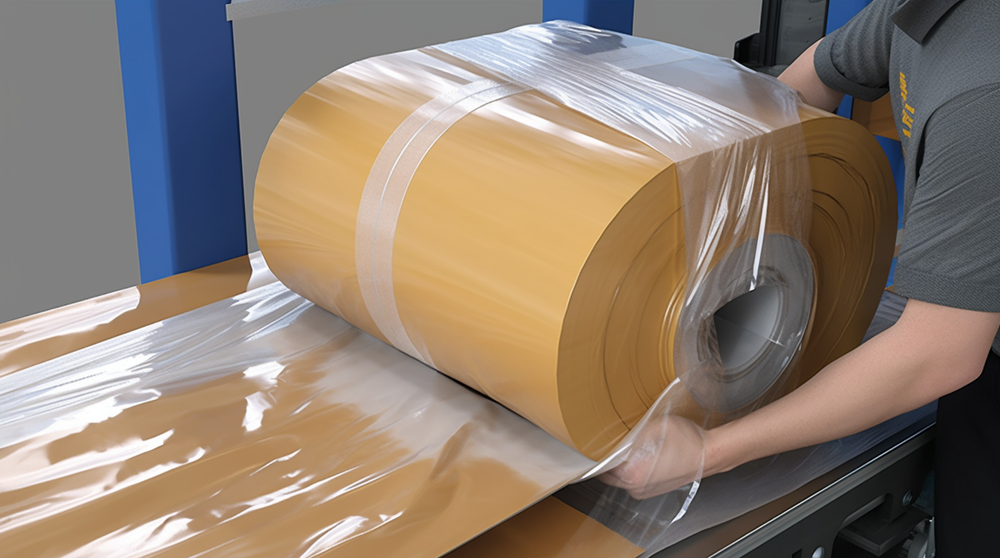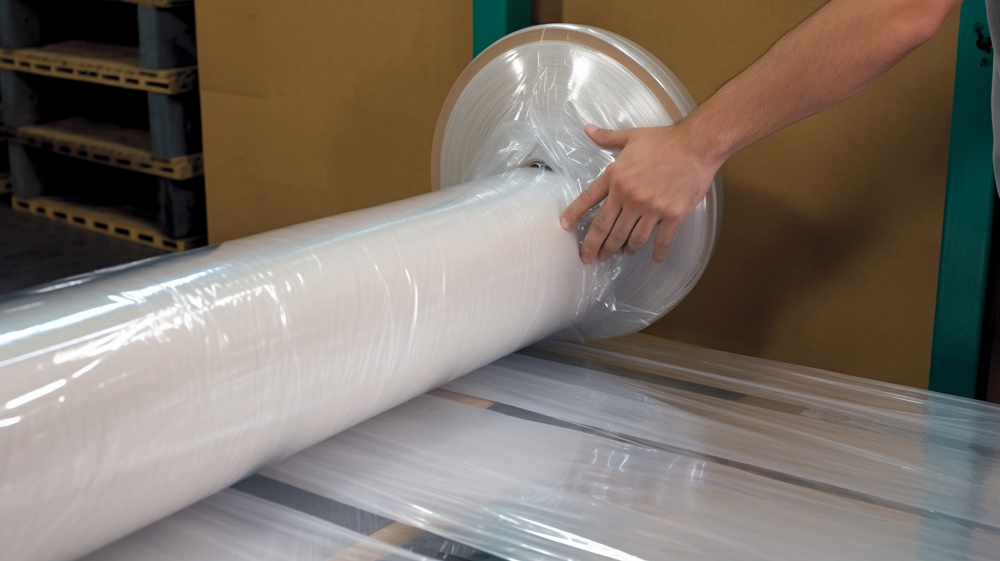In a world where customer experience reigns supreme, it’s more important than ever to master the ins and outs of stretch film for pallet wrapping. Why? Because nailing this process means ultimate load stability and customer satisfaction.
Efficient pallet wrapping with the stretch film is crucial for load stability. Learn about the operation flow, including assessing load stability, selecting the right film specifications, proper equipment setup, and applying the film with proper techniques. Follow expert tips for tension, stretch, film thickness, cling, tackiness, equipment handling, and film cutting and sealing for successful pallet wrapping.
So, let’s peel back the layers and unveil the secrets to successful pallet wrapping – trust us, the experts know a thing or two!

Overview of Operation Flow for Stretch Film Pallet Wrapping
Stretch film pallet wrapping is a crucial step in packaging that involves using a stretch film to securely wrap and protect a palletized load. The process follows a specific operation flow to ensure proper load stability and packaging.
Pallet wrapping is essential for various industries, including warehousing, logistics, transportation, and manufacturing, as it helps to protect the goods from damage during handling, storage, and transportation. It also prevents shifting, collapsing, or toppling of the pallet load, ensuring safe and secure transportation of goods.
The operation flow for stretch film pallet wrapping generally includes several key steps. It starts with assessing the stability of the pallet load and determining the specific packaging requirements. This is followed by selecting the appropriate stretch film roll specifications based on the load and application, including film thickness, width, and length. Proper equipment and workspace setup, such as stretch film dispensers or wrapping machines, is also essential to ensure an efficient wrapping process.
Once the load is prepared and inspected, the stretch film is systematically applied to the pallet load. This typically involves securing the film to the pallet with anchor wrapping and base wrapping, followed by applying primary and top wraps and securing the film at the top with a final wrap and seal.
To ensure effective stretch film pallet wrapping, it’s important to follow best practices, such as maintaining consistent tension and stretch, avoiding overstretching or under-stretching, managing film thickness and layers, and applying proper film cling and tackiness. Proper handling of stretch film dispensers and equipment and ensuring precise film cutting and sealing are also essential for a successful wrapping process.
| Benefits of Stretch Film for Pallet Wrapping | Explanation |
|---|---|
| Load Containment | Stretch film can hold the products tightly together and prevent them from shifting or falling during transit. This reduces the risk of damage, loss, or theft. |
| Product Protection | Stretch film can protect the products from environmental factors, such as moisture, dust, dirt, or UV rays. This preserves the quality and appearance of the products. |
| Cost Efficiency | Stretch film can reduce the packaging costs by using less material and labor than other alternatives, such as strapping, tape, or corrugated boxes. Stretch film can also be recycled and reused if handled properly. |
| Versatility | Stretch film can wrap various types of products, shapes, and sizes with ease and flexibility. Stretch film can also be customized with different colors, prints, or labels to suit different needs and preferences. |
Preparing for Pallet Wrapping
Assessing Load Stability and Packaging Requirements
The first step in preparing for pallet wrapping is to assess the stability of the pallet load and determine the specific packaging requirements. This involves considering factors such as the type of goods being transported, their weight, size, and shape, the mode of transportation, and the potential hazards during handling, storage, and transportation. Assessing load stability helps determine the appropriate stretch film specifications, such as film thickness, width, and length, to ensure adequate load containment and protection.
Selecting the Right Stretch Film Roll Specifications
Selecting the right stretch film roll specifications is crucial for effective pallet wrapping. The appropriate stretch film specifications should be chosen based on the load stability assessment. Factors to consider when selecting the right stretch film roll specifications include the load weight, size, shape, and potential hazards during transportation. For example, heavier loads may require thicker films, while irregularly shaped loads may require wider films or specialty films with enhanced puncture resistance. Choosing the right stretch film specifications ensures the film can effectively contain and protect the load during transportation.
| Stretch Film Types | Description | Application |
|---|---|---|
| Hand Stretch Film | A stretch film that is applied manually by hand. It is usually 12 to 18 inches wide and comes in various thicknesses and colors. | Ideal for small to medium-sized loads, irregular shapes, and low-volume wrapping. |
| Machine Stretch Film | A stretch film that is applied by a machine or a dispenser. It is usually 20 to 80 inches wide and has higher stretchability and puncture resistance. | Ideal for large and heavy loads, uniform shapes, and high-volume wrapping. |
| Bundling Stretch Film | A stretch film that is used to bundle multiple items together. It is usually 2 to 5 inches wide and has a high holding force. | Ideal for securing small or loose items, such as pipes, rods, or wires. |
| Specialty Stretch Film | A stretch film that has specific features or functions, such as color, venting, or anti-static properties. It can be used for various purposes depending on the needs of the user. | Ideal for enhancing visibility, ventilation, or protection of the products. |
Ensuring Proper Equipment and Workspace Setup
The right equipment and workspace setup are essential for smooth pallet wrapping. This includes ensuring that the stretch film dispenser or wrapping machine is in good working condition and properly calibrated. If using a manual stretch film dispenser, ensure it is ergonomic and easy to handle. The workspace should also be clean, well-lit, and free from obstructions to allow efficient and safe wrapping.
Conducting Load Preparation and Inspection
Before applying the stretch film, it’s important to properly prepare the pallet load. This may involve properly stacking and arranging the goods on the pallet to ensure even weight distribution and stability. It’s also essential to inspect the load for any protruding edges, sharp corners, or loose straps that may cause damage to the stretch film or compromise load stability. Addressing any load issues before wrapping helps prevent potential issues during the pallet wrapping process.

Applying Stretch Film to Pallet Load
After proper preparation, the pallet wrapping process’s next step is applying the stretch film to secure the load. This section outlines the steps in applying stretch film to the pallet load.
Securing Film to the Pallet
The first step in applying the stretch film is to secure it to the pallet. This involves anchoring the stretch film to the pallet to stay in place during the wrapping process.
- Anchor Wrapping: Start by securing the end of the stretch film to the pallet by wrapping it tightly around the bottom of the pallet or the base of the load. This helps to create a stable anchor point for the stretch film.
- Base Wrapping: Once the film is anchored, continue wrapping the film around the base of the load in a circular or spiral motion. Make sure the film is pulled tightly and overlaps each previous layer to provide a solid base for the subsequent wraps.
Applying Primary Wraps
After securing the film to the pallet, the next step is to apply the primary wraps to further secure the load. This involves wrapping the stretch film around the entire pallet and load to provide multiple film layers for increased stability.
- Techniques for Proper Application: Start at the bottom of the pallet and work your way up, applying the stretch film in a tight and even manner. Use a consistent and steady motion, overlapping each wrap by about 50% to ensure proper coverage.
- Ensuring Even Tension and Coverage: Maintain even tension on the stretch film as you wrap it around the pallet to ensure it is stretched and applied uniformly. Pay attention to the corners and edges of the load, as these areas may require additional wraps for added protection.
Applying Top Wraps
Once the primary wraps are completed, the next step is to apply top wraps to further secure and protect the load from the top.
- Techniques for Proper Application: Start from the top of the load and wrap the stretch film downward, covering the entire load. Use a consistent and overlapping motion to ensure complete coverage.
- Overlapping and Consistent Coverage: Overlap each top wrap with the previous one by about 50% to ensure proper coverage and load stability. Ensure the stretch film is applied tightly and evenly to prevent loose spots or gaps.
Securing Film at the Top
After applying the top wraps, the final step is to secure the stretch film at the top to prevent unraveling during transportation.
- Anchor Wrapping: Similar to the bottom, finish the wrapping process by securing the stretch film to the pallet with an anchor wrap. Wrap the film tightly around the top of the load or pallet to create a stable anchor point.
- Final Wrap and Seal: Complete the wrapping process with a final wrap around the top of the load, ensuring it is tight and secure. Seal the end of the stretch film to itself or the pallet to prevent it from unraveling during transportation.
Stretch Film Application Tips and Best Practices
Maintaining Consistent Tension and Stretch
Consistent tension and stretch are crucial for proper stretch film application. Maintaining consistent tension throughout the wrapping process is important to ensure that the film is applied uniformly and securely to the load. Avoid applying excessive force or insufficient tension, as both can result in inadequate load stability.
Avoiding Overstretching or Under stretching
Stretch film has a specific stretch limit, and overstretching or under-stretching can reduce load stability. Overstretching can cause the film to become too thin and lose its holding strength, while under-stretching may result in insufficient load containment. Follow the manufacturer’s recommendations for the film’s appropriate stretch level to achieve optimal load stability.
Managing Film Thickness and Layers
The thickness of the stretch film and the number of layers applied can impact load stability. Thicker films generally provide better puncture resistance and load containment, while multiple film layers can increase load stability. Consider the load’s weight, shape, and fragility when determining the appropriate film thickness and several layers to use.
Applying Proper Film Cling and Tackiness
The cling and tackiness of the stretch film are important factors in ensuring load stability. Proper cling and tackiness allow the film to adhere to itself and the load, creating a secure bond. Consider the type of load being wrapped and the environmental conditions during transportation to select a stretch film with the appropriate cling and tackiness properties.
Handling Stretch Film Dispensers and Equipment
Proper stretch film dispensers and equipment handling are crucial for efficient and effective application. Familiarize yourself with the operation of the stretch film dispenser or equipment used and follow the manufacturer’s instructions for safe and proper use. Ensure the dispenser or equipment is in good condition and properly adjusted to prevent any issues during application.
Ensuring Proper Film Cutting and Sealing
Cutting and sealing the film is the final step in stretch film pallet wrapping. Use a sharp cutting tool or a film cutter to cleanly cut the film without damaging the load or the stretch film. Ensure that the film is properly sealed at the beginning and end of the wrapping process to prevent unraveling during transportation.

Efficient pallet wrapping using stretch film is crucial for load stability and effective packaging. By understanding the operation flow and following expert tips and best practices, you can ensure successful pallet wrapping and protect your pallet loads during transportation. Read on to gain valuable insights and optimize your pallet wrapping process for improved efficiency and customer satisfaction.














